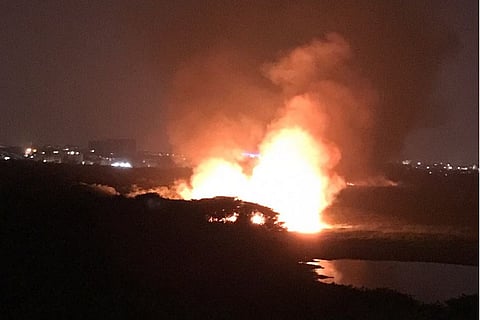

Five days after Bellandur lake, Bengaluru’s largest lake, caught fire, the National Green Tribunal asked the state to submit timelines with regard to the rejuvenation of the water body.
The green court directed the government to give stepwise timelines for removing silt, to block the sewage entry points, for cleaning up the lake and to upgrade sewage treatment plants (STPs) by January 29.
On Jaunary 19, Bellandur lake caught fire for the third time in recent memory.
Bengaluru Development Authority (BDA) Commissioner Rakesh Singh, who appeared in court on Wednesday, said that the fire was a result of some mischief by miscreants.
Firefighters had told TNM that even if the fire was lit by cattle rearers, the presence of flammable waste and sewage led to the fire spreading. The fire raged for over 30 hours and it took a joint effort by fire and defence personnel to put it out. Forty acres of the lake bed was destroyed.
The NGT had taken up the issue after taking suo motu cognisance of the matter after the lake caught fire for the second time in February 2017.
How polluted is Bellandur’s water?
Water samples collected by the Ashoka Trust for Research in Ecology and the Environment (ATREE) from the lake a day before it caught fire suggest that the pollution level of the Bellandur lake is deplorable.
Scientists at ATREE tested samples of water from Bellandur from different five points – three inlets (HAL, Koramangala, Agara) and two outlets (Kempapura, Yamalur) are far below the levels recommended by the National Pollution Control Board.
None of the samples collected at Bellandur meet the minimum dissolved oxygen (DO) content as mandated by the National Pollution Control Board.
The D Class of water, according to NPCB, which is only for propagation of wildlife and fishery (not fit as a source of drinking, bathing), calls for a minimum DO level of 4 (mg/L).
Among the samples collected, the best DO level was found at the Kempapura outlet, which had a DO of 3.15. This outlet stands out in all other metrics too – however, it still does not match the levels required for fishes to survive. Additionally, the high presence of ammonia makes it impossible for pisciculture in any part of the lake.
What is a clean lake?
“First of all, we don't know what authorities mean when say that we want a clean lake. Even for recreational use, the measure for E. coli here is very high. But, according to the National Pollution Control Board standards, there is no standard for E. Coli,” Priyanka Jamwal, a scientist at ATREE told TNM.
She added, “The COD at the outlets are much higher than those at the inlets, which suggest some sort of bacterial activity in the lake. The DO levels also suggest that very little of the sewage is getting treated. Many components of domestic sewage, like cooking oils and other hydrocarbons, are highly flammable, helped the fire burn. The presence of industrial effluents can be tested for further analysis.”
She further said there needs to be a thorough scrutiny of treated water from the city’s STPs as they are not well equipped to handle strong chemicals and antibiotics used in present day domestic products.
In a meeting chaired by Bengaluru Development Minister KJ George earlier in the week, Bangalore Water Supply and Sewerage Board (BWSSB) chief Tushar Girinath claimed that 75% of the sewage flowing into Bellandur lake will be treated. At present, only a maximum of 250 MLD of treated sewage flows into the lake, the rest is untreated sewage.
“This is the irony, that even after treatment, they are dumping the treated water into the same lake. So much money and hard work to treat the 200-250 MLD of water goes down the drain and mixes with 500-600 MLD of untreated water,” she also said.
This is not the only lake where this is happening. Barring Jakkur lake, where there is a strong civil society group, every lake in the city receives a significant amount of untreated sewage.